The Samsung Galaxy S6 and S6 edge Review
by Joshua Ho on April 17, 2015 9:00 AM EST- Posted in
- Smartphones
- Samsung
- Mobile
- Galaxy S6
- Galaxy S6 Edge
System Performance
In order to test the Exynos 7420 and the phone in general, we turn to our suite of benchmarks which are able to show how the device performs in common general computing workloads. Something as simple as web browsing is still surprisingly intensive on mobile phones, and in general Android can often be quite stressful to run in the constraints of a ~3W total TDP especially on any phone still running Dalvik due to its strong reliance on bytecode and a virtual machine that translates bytecode to machine code just before and during application runtime. ART improves this significantly, but is limited in the nature of optimization as AOT compilation optimizations are limited by the CPU power of the SoC and the need to compile the application in a reasonable amount of time.
As always, we'll start things off with our browser benchmarks. After getting to use the phone, it became clear to me that Chrome is poorly optimized against the Galaxy S6 as Samsung’s browser is clearly superior in performance. For that reason I've gone ahead and run our benchmarks on both Chrome and on the stock browser, as seen below.

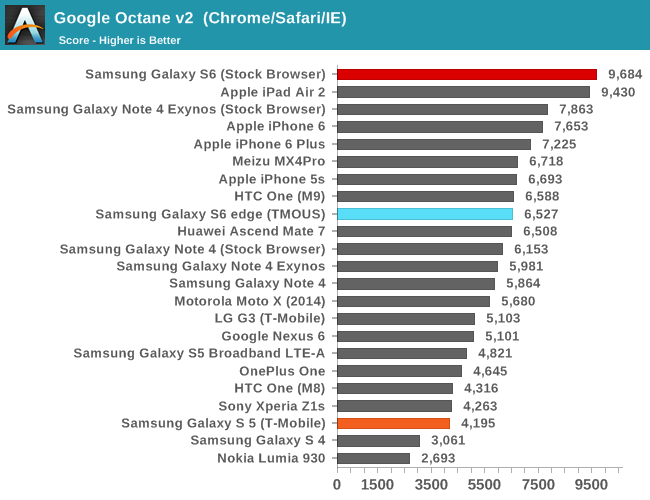

Needless to say, in order to see the full potential of the Exynos 7420 and its cluster of A57s, it’s necessary to use Samsung’s stock browser. This performance is really quite amazing when compared to Apple’s A8X, which has basically been the gold standard for performance in the mobile space in the context of ARM SoCs.
Moving on, as a part of our updates to the benchmark suite for 2015, we'll take a look at Basemark OS II 2.0, which should give a better picture of CPU performance in addition to overall device performance.
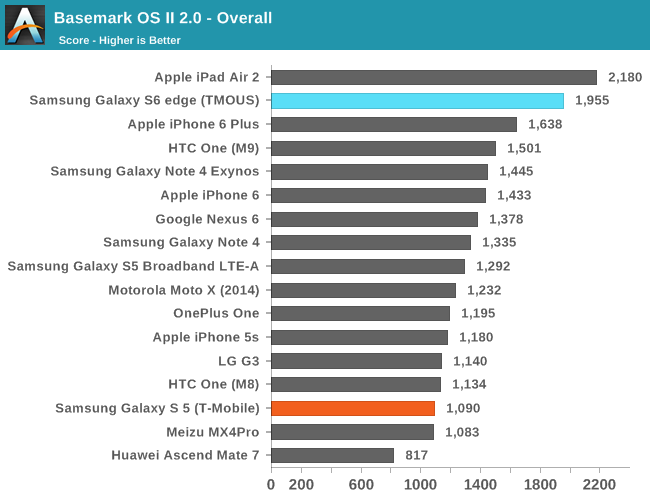
The browser benchmarks seem to hide some pretty enormous variability as the Galaxy S 6 edge (which is comparable to the Galaxy S 6) sets a new record among Android devices. The only challenger is the iPad Air 2, which uses the A8X SoC with three Enhanced Cyclone cores and the semi-custom GXA6850 GPU.
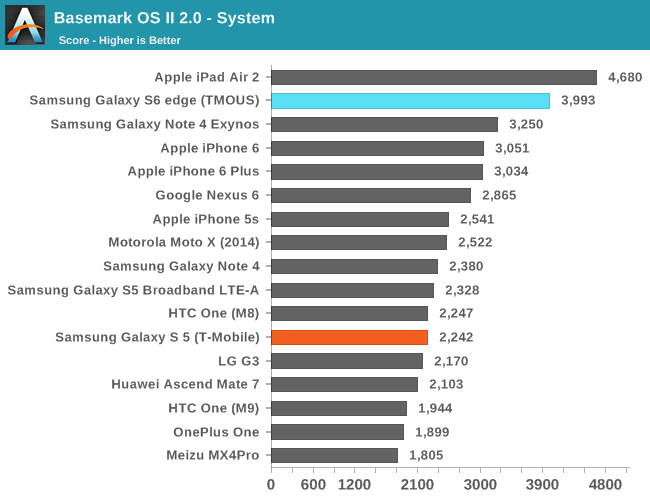
This system test contains a floating point and integer test, in addition XML parsing, which means that this test mostly stresses CPU and RAM. Interestingly enough, the Exynos 7420 pulls far ahead of both the Exynos 5433 and Snapdragon 810 in this test, and approaches the A8X. The difference between the 5433 and 7420 is likely a combination of the higher clocks on both the A57 and A53 clusters for the 7420 (1.9/1.3 on the 5433, 2.1/1.5 on the 7420), in addition to the ability to stay at a high 'overdrive' clock due to reduced leakage from the 14LPE process. The One M9 likely falls a bit short here due to HTC's governor settings restricting the use of all 8 cores simultaneously.

While one might guess that the memory test of 'Basemark OS II 2.0 - Memory' is of RAM, this is actually a test of the internal storage. Once again we see the S6 edge come close to leading the pack due to the use of the new UFS (Universal Flash Storage) standard. Casual examination reveals that the S6 edge has a queue depth of 16, and that it identifies itself with the rather cryptic model name of KLUBG4G1BD-E0B1.
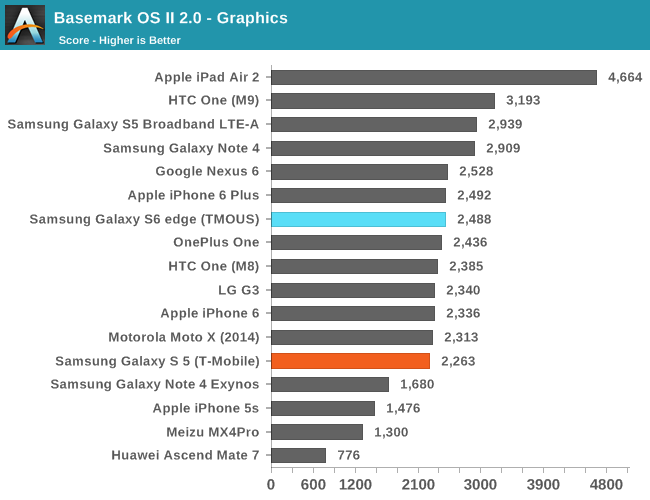
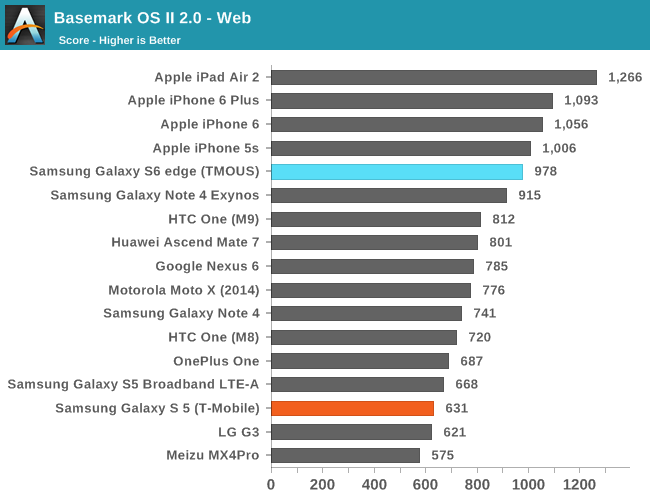
For the web test, it uses the built-in WebView rendering engine rather than Chrome and paints a distinctly different picture, especially because these tests are focused on HTML5 and CSS rather than JavaScript. Here we can see that the iPhone 6 and iPad Air 2 continue to hold their lead, but the Galaxy S6 is pretty much the king of the hill when it comes to Android devices.
Our next system benchmark is PCMark, which does a number of basic benchmarks designed to stress various aspects of the device in everyday workloads like video playback, web browsing, text editing, and photo editing. This tends to test every aspect of a mobile device, unlike microbenchmarks that can often miss aspects of the system that can affect performance.
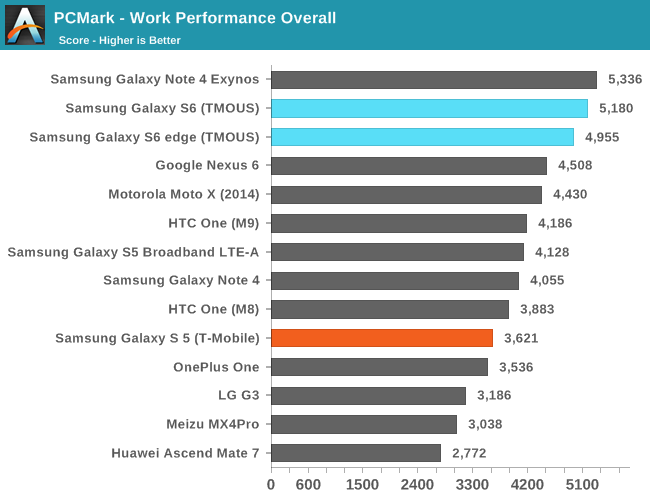
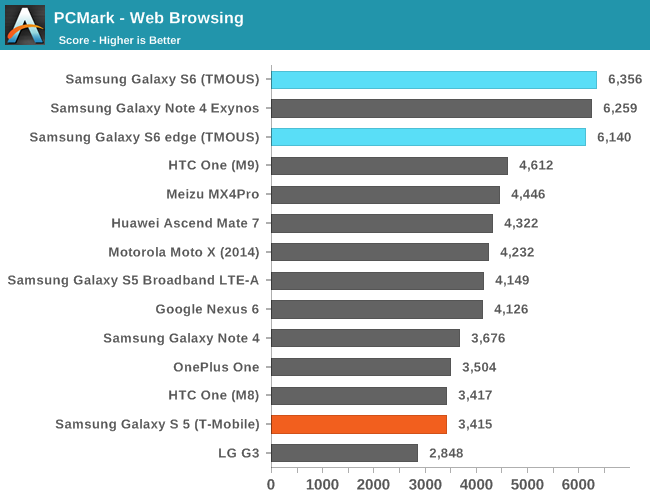
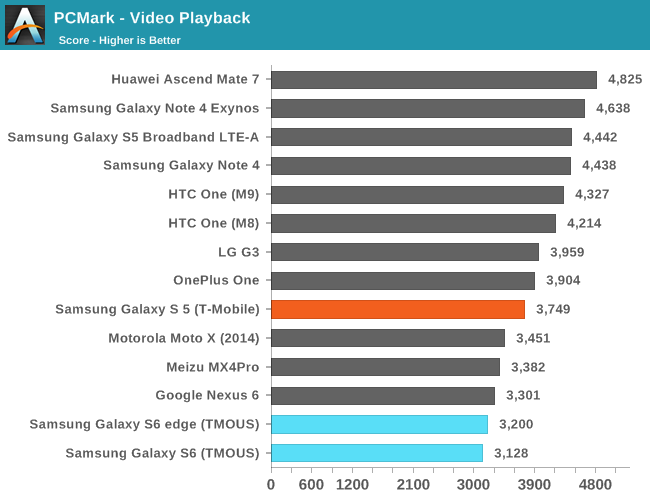
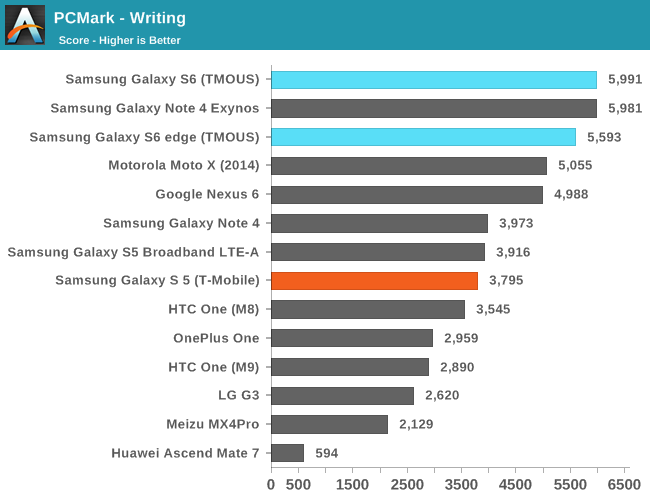

In these tests, the Galaxy S6 continues to perform strongly here due to the fast NAND storage solution and the Exynos 7420 SoC. As we have already covered the Basemark OS II 2.0 results in previous articles, I would refer back to it as those scores are final and have already been contextualized.
Overall, in these general purpose computing tasks that stress CPU, memory, and NAND performance we can see that the Exynos 7420 is off to a flying start. Samsung Mobile should focus more strongly on optimizing the software stack against Chrome as mobile Chrome has around twice the user share of stock Android browsers. I often say that the SoC is the foundation to a good smartphone, and in the case of the Galaxy S6 it feels like this is especially true.










306 Comments
View All Comments
Andrei Frumusanu - Friday, April 17, 2015 - link
Math is hard, corrected, thank you.Arbie - Friday, April 17, 2015 - link
SD Police here: no microSD, no sale. The reasons have been hashed over endlessly but I know what I want.mayankleoboy1 - Friday, April 17, 2015 - link
Im very puzzled by the large differences between the stock browser and Chrome. They both are based on the Blink engine, and use V8 for JavaScript execution.This definitely points to "optimizations" done in the stock browser for these benchmarks.
Could you do some other benchmarks on the phones?
JoshHo - Friday, April 17, 2015 - link
Basemark OS II and PCMark use the internal WebView engine and the 7420 doesn't do nearly as poorly in those browsing benchmarks as it does on Chrome.It's likely that Samsung Mobile has some work to do when it comes to optimizing against Chrome.
lilmoe - Saturday, April 18, 2015 - link
Or, it's the other way around. Google needs to do a LOT of work of optimizing Chrome for the various hardware out there, especially the most popular ones.Chrome isn't getting the highest marks in optimization you know, especially on the desktop. I thought that was a well known and understood issue?
Bob-o - Saturday, April 18, 2015 - link
Can someone explain to me why an application needs to be optimized for certain hardware? Isn't it just using libraries for rendering (OGL, whatever), and those libs have already been optimized for the GPU? And the non-rendering part of the app should be byte-compiled appropriately?Back in the 1980's I used to optimize apps for certain hardware. . . in assembly code. What are they doing these days? And why is it necessary? Poor abstractions?
mayankleoboy1 - Sunday, April 19, 2015 - link
These optimizations are not for specific hardware, but for the specific BENCHMARK. They can easily tweak parameters inside the Javascript engine to give higher score on specific benchmarks like Octane and Kraken. These optimizations would negatively affect the common web JS workloads, but would give higher benchmark score.Google/Mozilla wouldnt do such shenanigans as they do not priortize for specific benchmark, unless it also improves general JS workloads
bji - Friday, April 17, 2015 - link
I have a big problem with the way their camera module juts out from the back of the device. I have a Galaxy S5 Active (my first smart phone) and the camera broke within about 2 months of ownership. I believe it's because it juts out and is a focal point of stresses as a result (pressure while in pocket, pressure when laid on a flat surface, etc), and the very weak glass they use to cover the lense is subject to breaking. I've read many comments from others that this happened to them, and it happened to me. Now the camera is useless.I could put a big ugly case on the thing to protect the camera, sure, but that's why I bought the Active - because I didn't want to put a case on my phone.
I see that Samsung continues with this horrid camera module design. I won't be buying another Samsung with this characteristic.
name99 - Friday, April 17, 2015 - link
I suspect Samsung would do well to copy Apple in one more respect --- making cases a big part of the user experience.Something that critics of the iPhone 6 (in particular the "slippery sides" and "too much sacrificed for thinness" don't seem to get is that, IMHO, Apple sees cases as a significant part of the iPhone experience. Which is why they provide their own --- expensive but very nice --- high end cases, and are willing to accept the inevitable leaks we see from case makers in advance of new products.
Once you accept that a case is part of the story
- the thinness makes more sense, because you're going to be adding a few mm via the case
- likewise the camera bulge, while less than ideal, is not such a big issue
- likewise complaints about the fragility of glass backs, etc.
Cases also allow for a dramatic level of customization without Apple having to stock a zillion SKUs. You could even argue that the aWatch band proliferation is Apple having learned from the size of the case market for iPhones and iPads, and arranging things so that they get the bulk of the high-end money that's available in this space.
Every other phone manufacturer is in a much weaker position than Apple because they don't have the massive range of cases available. But they could at least try to improve the situation by providing their own cases --- maybe at least a high end leather model, a low-end plastic model, and an "I'm paranoid I'm going to drop my phone" model. They should also call out the cases during the big press reveal of each phone (like Apple does) and ship some cases along with each review unit (not sure if Apple does this, but they should).
All of which makes the Edge, IMHO, even more of a gimmick (in spite of Samsung claiming they will no longer do gimmicks). You get a much more expensive manufacturing process to provide something whose real functionality could probably be provided with a few colored LEDs, and you dramatically reduce the design space available for cases.
Oh well. Stay tuned for the next Samsung model which (don't tell me, let me guess) will feature as its big new feature a haptic (don't call it Taptic!) engine and which, with any luck, will manage to ship in at least one country before the iPhone 6S, so that Samsung can claim (and have the true believers accept) that this was their plan all along, that they were in no way influenced by Apple's obvious [based on aWatch and MacBook] next big UI element.
akdj - Sunday, April 26, 2015 - link
Hi name99. Wish there was an up vote;). Well said. As an owner of the iPhone 6+ (& each iteration before it), I've 'finally' found the Apple iPhone case:). Lol. I bought some Platinum Incipio Pro kickstand crap, a really lame Spec case (& I love their laptop shells on my MBP) before I finally made a trip down to the Apple Store and picked up the simple, brown leather iPhone 'Apple' case (I don't remember it being expensive though, seems like 39, maybe 49 bucks? Seems like the standard pricing regardless of manufacturer out of the gate).I'm embarrassed to say since 2007, I've never had the Apple case. Always bought third party and typically Mophies starting with the iPhone 4/4s.
Sorry, TL/dr -- not in defense of Android OEM lack of third party peripherals as its true but this last year, 18 months has changed some. The S-View case specific to the 's' and 'note' brands are pretty sweet. I use one on my Note 4 and like the Apple cam/case combo the S-Case also protects the camera protrusion while adding even more functionality. It's magnet sensing for turn on/off by open/close and the small maybe 2" x 2" 'S-View' (small window on front) allows answering of calls, quick text/tweet/FB/email/whatever-u-set-up response capability, notifications and time (customize faces and information on clock), weather and 'maps', settings, and more. It's slick and it's protective.
But you're right. The Apple iOS cases kick ass. I own the 'smart' cases (not covers, they suck) on our iPads too. Be nice if they quit changing the dimensions ever so slightly each iteration ala iPhone. Usually get two generations of the iPhone outta one case. Single on an iPad. Oh well. Keep em longer too I suppose).
Good to see another avid iOS user. I love both and have since the original 4GB, non subsidized $500 2G iPhone and the Xoom/S1 ...and to date I'm undecided. Don't play with the new Amdroids. They're very nice as well. It's too dangerous now with AT&T/Verizon, even Best Buy, etc. just pick what you want. The color. The capacity. No money down and NEXT fools ya. Before you know it, you've got iPads for everyone in the family. A pair of Nexus 7s you're trying to figure out what to do with, iPhones and Notes... Just 'try' the M9, or the G3/(4 coming?) what the heck, can't hurt. Before you know it you've got a dozen devices all accessing your data, exponentially increases bandwidth used on wifi and LTE for updates and the ilk. And a $700 'phone' bill. Lol. Too cool.
Does t matter which way you go, iPhone 5s/6/6+ or S5/Note4/G3/M8 or 9, Note 4 or this bad boy. They're ALL 'computers' in our pocket. Across the board faster and more energy efficient than computers we used last decade. The storage. The connectivity. The processing and RAM, controllers (micro); accelerometer, barometer, proximity and Bluetooth 4.1, wireless AC and 2x2 antenna arrangement ...without... An antenna ( those of us in our forties, probably mid to late thirties remember those, right? ...other than the sweet 'bands' on my 6+;) course hidden by earlier do dissed Apple's iPhone case. iPad cases. They're sweet. Kinda like their trackpads in comparison to EVERY other OEM. They work. All. The. Time. They NEVER don't. WTH can't Windows get an OEM partner to nail the trackpad? Perhaps that's why they decided on 'touch'? :-)